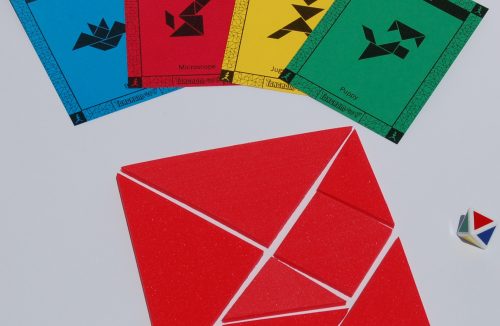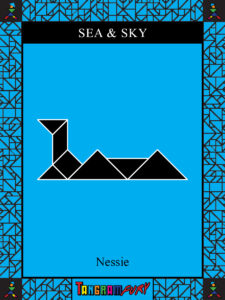
Tangram Fury Rules of the Game
It’s really simple:
Roll the die to select a category.
Pick a card and lay it down.
First one to build the image with their puzzle pieces, wins the card.
First one to earn five cards, wins the game.
Number of Players
Tangram Fury is designed for four players to race each other individually. But, it can also be played as teams. When this happens, it’s almost as much fun to watch as it is to play – as the teams fumble over each other snatching puzzle pieces and frantically trying to coordinate their efforts to build the shape.
Tangram Fury Game Components
- 4 Tangram Puzzle Sets: Each set contains 7 geometric pieces (tans). One set per player for up to 4 players.
- 4 Decks of Puzzle Cards: Each deck represents a category of tangram puzzles:
- Blue: Fish & Birds
- Red: Objects & Shapes
- Yellow: People
- Green: Animals
- 1 Eight-Sided Die: Color-coded to select card categories. Each of the four colors (Blue, Red, Yellow, Green) appears twice on the die.

Step-by-Step Rules
Objective: Be the first to collect five puzzle cards (or one of each color in Rainbow Version) by building tangram puzzles faster than opponents.
Setup:
- Each player receives a set of 7 tangram pieces and builds the traditional square tangram before play begins.
Gameplay:
- The player with the nearest birthday rolls the 8-sided, color-coded die first to select a card category (Blue: Fish & Birds, Red: Objects & Shapes, Yellow: People, Green: Animals).
- The roller chooses Fan (outlines shown) or Expert (silhouette only) mode, draws a card from the rolled category, and places it face-up for all to see (orienting it as desired).
- All players race to build the card’s puzzle using all 7 pieces, which must lie flat and not overlap.
- The first to finish yells “Done!” and wins the card if correct.
- The next player rolls. Pieces remain as-is between turns.
- The first to collect 5 cards wins.
Levels of Play:
- Fan Mode: Cards show piece outlines for easier puzzles.
- Expert Mode: Cards show only silhouettes for a tougher challenge.
Upside-Down Cards:
- Cards may appear at odd angles or upside down depending on players’ positions around the table, enhancing the mental challenge and creativity.
Triple Play:
- If the same color is rolled 3 times in a row, any player can yell “Triple!” The first to rebuild their pieces into the original square tangram wins and chooses the next card’s color (but not the mode). The roller still selects Fan or Expert mode.
Rainbow Version:
- Play as above, but the winner is the first to collect at least one card of each color (Blue, Red, Yellow, Green). Game length varies based on die rolls and wins.
Playing Tips
- Build What You See: Cards may appear upside down or sideways depending on your seat. Build the puzzle exactly as shown—don’t waste time reorienting it in your mind.
- Embrace the Challenge: Odd angles boost spatial reasoning. Lean into the difficulty to sharpen your skills and gain a competitive edge.
- Stay Focused: Some cards look similar but have slight differences to distract you. Ignore the déjà vu, keep building, and outpace opponents who pause to question.






